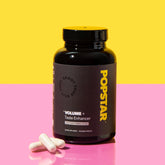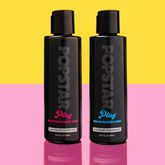

June is LGBTQIA+ Pride month! A time to honor the anniversary of the Stonewall Riots by taking it to the streets adorned in rainbow garb and body glitter! It is also a time for brands to change their logos on every social media platform and pretend to be interested in LGBTQIA+ rights for 30 days (we’ve all seen the memes). There are numerous ways to show your Pride including family-friendly Drag Queen Story Hour, boozy brunches, parades, and even some more scantily clad events!
For some party-goers, Pride and promiscuity are synonymous, as they celebrate their pride with sexual liberation and exploration. For those who choose to celebrate Pride with their peckers, you need to make sure you are prepped for the post-parade afters! Or, in this case, PrEP’d. To celebrate Pride in the best way we know how, Popstar is here to provide you, dear reader, with information on all things PrEP.
What is PrEP?
PrEP stands for pre-exposure prophylaxis. Think of PrEP as your sexual safety net, a way for HIV-negative individuals to reliably prevent contracting HIV through regular use of antiretroviral medication. While many of these medications have been around for quite some time for the treatment of HIV, they have only recently been used in HIV prevention.
How does PrEP work?
Let’s dive a little deeper into how pre-exposure prophylaxis works and view the process from a microscopic mini Magic School Bus level, shall we? PrEP is like a forcefield for your immune system and without access to our immune system, HIV is unable to establish infection.
pre-exposure prophylaxis has two primary active ingredients, tenofovir disoproxil fumarate (TDF) and emtricitabine (FTC). When PrEP is taken consistently, it allows for TDF and FTC to build up in the bloodstream and mucosal tissues. Both medications interfere with HIV’s ability to replicate and spread within the body. Essentially, taking PrEP regularly is like having the biggest kid in class on your team for Red Rover. If HIV enters the body, it gets clotheslined and is unable to break through.
PrEP can be administered as a daily pill or as a longer acting intramuscular shot given in your doc’s office every couple of months.

Side Effects
While the majority of users don’t experience any serious adverse effects, there are a few mild side effects that can occur. Many of these side effects can persist for only a short while as your body adjusts to this new medication. Like those of many over-the-counter medications, PrEP symptoms can include nausea, headaches, as well as a change in appetite.
Will I still need condoms?
Here at Popstar, we are still avid proponents of the “no glove, no love” rule. While pre-exposure prophylaxis has been clinically proven to prevent HIV, it does not stop the spread of other sexually transmitted infections (STIs). The combination of condoms and PrEP is a match made in heaven in lowering your risk of infection. The PB&J or Batman and Robin of boinking, if you will.
Speaking of STIs, keep in mind that prescribing providers often require a full STI panel every three months in order to refill PrEP prescriptions. Frequent screening can lead to treatment when necessary, helping to reduce the spread of STIs.
Ready to get PrEP’d?
If you are someone who is sexually active and would like the peace of mind PrEP provides, speak to your primary care provider to see if pre-exposure prophylaxis is right for you! Should you choose to show your pride promiscuously this June, make sure you are PrEP’d and ready! We hope that you have a safe (and sexy) time celebrating!








